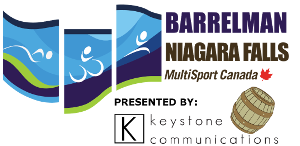Barrelman pro Heather Leiggi’s race day nutrition advice
Nutrition — it’s the 4th discipline of triathlon. When starting out in the sport of triathlon, not only do we need to learn how to swim, bike and run, but we also need to learn how to fuel and hydrate our body during training and racing, especially if doing the longer distance races. You can do all the training in the world but if you are not hydrated and fueled properly, you will not be able to enjoy the benefits of your hard work. Here are some tips to get you started in the right direction:
1) First of all, practice, practice, practice. Practice your nutrition strategy during your training before trying it out in races. You should be practicing your race day plan during each and every session, especially if you are new to racing. Not only does this help you learn what works and what doesn’t, it also trains your body to absorb and utilize the fuel. Putting a training race or 2 on your schedule to practice your nutrition before a big race is a good idea as well. This gives you the chance to try out your plan and adjust it as needed. It might seem like a lot to think about at first, but once you get it dialed in, it becomes second nature.
2) Start the morning off right by getting in a good breakfast. I know triathlons start REALLY early in the morning, and often it’s hard to want to eat that early, but you do need to start race day fully fueled and hydrated. Aim for 300-500 calories and figure out how much time you need to digest your breakfast (again, this is something you should be practicing in your training). Some athletes can eat 1hour before a race while others need 3hours to fully digest and avoid stomach issues during the race. Breakfast foods should include easy to digest carbs with a little bit of protein and fat. Find out what you like and what is going to work for you. Some common athlete breakfasts include toast with peanut butter, a banana with almond butter, oatmeal with peanut butter/banana, rice. It’s often a good idea to steer away from high fiber foods such as oatmeal or dairy products but if they work for you without issues then go for it! And don’t forget to hydrate with water or a sports drink. If you are a coffee drinker, a cup is ok on race morning too.
3) Use these basic fueling guidelines as a starting point. Fluids: 25-33fl oz/hr (1 large bottle is 24 fl.oz.). Calories: 250-400cal/hour (1 gel is ~100cal, 1 bar ~200-250cal, sports drink is ~150cal). Then make adjustments. Everyone is different in their ability to absorb calories so you will have to try out different options. It will take some trial and error to find what works best for you. Try different brands, try different combinations of solids and liquids, and try different quantities. Keep in mind too, just like your body needs time to adapt to the training, your gut needs time to learn to absorb the calories and fluids while exercising. So, the more you practice, the more efficient your gut will get.
4)Find out what nutrition will be available at the aide stations of your upcoming race and practice with it. It helps if you can use the aide stations for fueling so you don’t have to carry as much with you on race day. Plus, in case of an emergency (dropping your bottles or gels, forgetting stuff in transition, not having enough with you) you will be more at ease knowing that you can use what they have on course.
5) Have a race day eating and drinking schedule. Write it down and memorize it. You can set your watch to beep every time you should be drinking or write the schedule down and tape it to your handle bars. It’s easy to get distracted during the race so it helps to have reminders.
6) Consider waiting 5-15min after transitioning to eat or drink. Sometimes trying to eat or drink before the HR has a chance to settle down makes you more likely to have stomach issues. Sip on water initially until your HR settles down and you’ve settled into your effort.
7) What works on the bike may not work on the run. Athletes often find it easier to take in more calories on the bike and are more likely to tolerate solid foods on the bike. Make sure you have a plan for both the bike and the run and keep in mind they will probably differ. If you are going to take in some solid foods on the bike, aim to take them in during the first half of the bike. This gives them a chance to digest and will decrease the chance of GI issues on the run.
8) Should you use sodium supplements during the race? There are a lot of factors that change the amount of sodium you need on race day (length of the race, amount you sweat, race day conditions, etc.). For this reason, I recommend my new athletes start by getting their hydration and fueling needs down before playing around with sodium supplementation. However, the general guideline for sodium is 500-800mg/24oz. of fluids so that is a good place to start. The hotter the race or longer the race, the more important the extra sodium will be. Remember to include the sodium that is in your sports drink, gels, bars, etc. when counting.While this seems like a lot of preparation and experimentation in the beginning, once you get a good plan together, you will only need to make minor adjustments from race to race. And after all, with all the time and effort you are putting into training for your upcoming race, you want your body performing at it’s best on race day!
